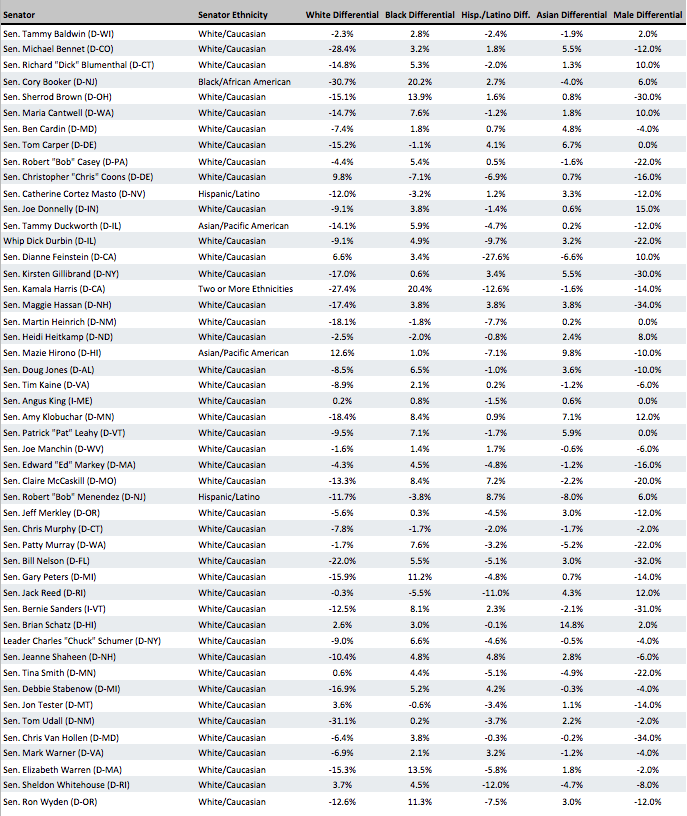How diverse are Democratic Senate offices? You might be surprised …
In 2007, then-Senate Majority Leader Harry Reid (D-NV) created the Senate Democratic Diversity Initiative as a way to increase diversity among the chamber’s staff. The Initiative’s primary goals are twofold: First, to help Democratic Senators staff their offices with aides who reflect the demographics of the states from which they are elected; and two, to recruit, retain, and develop a Senate workforce that spans the racial, ethnic, and socioeconomic spectrums.
As part of these efforts, the Initiative conducts an annual survey of aides within the 49 Democratic—and the two Independent—Senate offices. The survey asks respondents to select their race/ethnicity and their gender. On July 15th, the Initiative released the results of its second staff survey.
The office breakdowns provided by the survey are useful by themselves. For example, they show us that:
- The average ethnic makeup of Dem. Senate offices is 66 percent white, 13 percent black, 10 percent Latino/Hispanic, 8 percent Asian, and 2 percent Native American. Only Latino/Hispanic staffers are underrepresented within the Senate (by 8 percentage points) when compared to national demographics.
- 26 Dem. Senators employ a staff that is at least one-third (33 percent) non-white. For comparison, the percentage of non-white persons within the United States is 23.4 percent. Sen. Schatz’s (HI) staff is 72 percent non-white, with 59 percent of his staff classifying themselves as Asian or Pacific Islander.
- 22 Senators have a higher percentage of black or African American staff than the 13.4 percent within the United States. Sen. Jones (AL) has the highest percent (33 percent) of black staff.
- Only 11 Democratic Senators employ more men than women. Sens. Van Hollen (MD) and Hassan (NH) lead the chamber in highest percentage of female staff with 67 percent. (It’s important to note that this tells us nothing as to which jobs are held by females. I have previously shown that in the House women, despite their numbers, are more likely than men to hold more entry-level and administrative positions.)
Despite the novelty of the staff-level data provided by the survey, a deeper dive is necessary to better quantify the degrees to which Senators hire staffers that reflect their states. After all, the demographics of Vermont are quite different from California, and we would expect—hope, even—the hiring choices of each Senator to mirror the populations found within the state populations they represent. Descriptive representation doesn’t begin and end with the member; who they hire counts, too.
Thus, I compared Senators’ office demographics found within the Initiative survey with those of their elected states using the Census Bureau’s 2016 American Community Survey 5-year estimates. Doing so allows us to parse out which Senators’ staff are more or less diverse than their constituents.
Overall, this snapshot of Democratic Senate aide diversity offers several encouraging data points:
- Despite only six of the 49 Senators being racial minorities themselves, the average Democratic Senate office is 9.6 percent less white than their respective state population. In fact, only eight of the 49 Dem. Senators have a higher percentage of white/caucasian staffers than their state populations. Sens. Udall (NM) and Booker (NJ) have the highest differentials in the sample, with both hiring staffs 30 percentage points less white than their state demographics.
- 40 Senators have higher proportions of black/African American staffers than their states, leaving nine offices with fewer blacks than the state demographics would predict. The proportion of staffers who are black within Sen. Harris’ (CA) office is 20.4 percentage points higher than the proportion of African Americans within California, the highest differential of all Senate Dems.
- Despite Latinos generally being underrepresented within the chamber, 18 Senators have a higher proportion of Latino staffers than their state demographics. Latinos make up 19 percent of the population in New Jersey, for example, but Sen. Menendez’s (NJ) staff is 28 percent Latino/Hispanic, the highest differential in the chamber and likely connected to him being one of the two Hispanic/Latino Democratic Senators.
How diverse are your Senators’ offices? The table below provides differentials for each of the ethnic/racial groups reported within the survey, as well as staffer gender breakdowns within each Senate office. Differentials are calculated by subtracting the percentage of the states’ demographics from office demographics (i.e., black differential = office black % – state black population %).

Notes on the methodology:
- The percentage of white staffers is calculated by subtracting the listed percentage of non-white staffers within each office from 100.
- Many percentages may not equal 100 largely because of how Hispanic/Latino respondents are asked to categorize themselves. Read more about this process here.
- Male differences listed in the table are calculated by: percentage of male staff – percentage of female staff. Thus, higher differentials represent offices with higher proportions of male aids.







